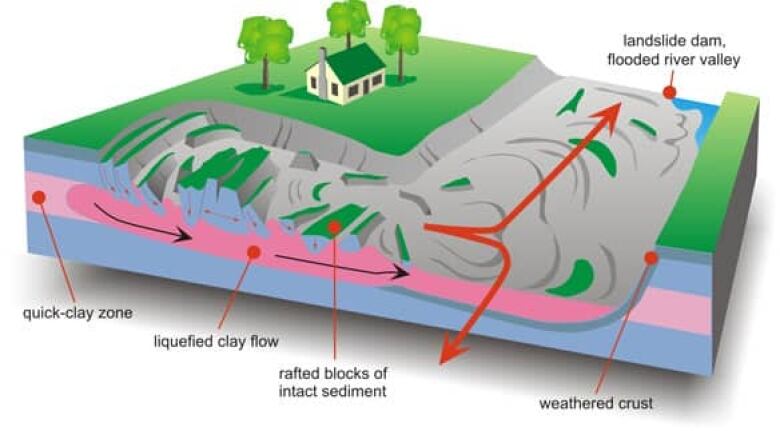Why the ground suddenly gives way
A family home was sucked into the earth by a landslide in Saint-Jude, Que., late Monday night, killing a family of four, but miraculously their dog, a golden retriever named Foxy, was found alive.
The cause of the catastrophe was at first reported to be a sinkhole, though experts now say it was a retrogressive landslide.
The home was located on a riverbank on ground that is predominantly Leda clay, which is a soft, marine clay often found in the Ottawa Valley that can easily liquefy. For this reason, there is some speculation as to whether this was ever a safe environment to build a home.
"I would say generally speaking, building a house on the shore of the river in a clay environment is already a risk by itself," Aime Bensoussan, engineering geologist and president of Inspec-Sol Inc., a geotechnical consulting firm, told CBC News Network on Tuesday morning.
"Now, I believe — I am assuming — that probably there were already some minor cracks in the last weeks that for a knowledgeable observer would have been a sign that something was going to happen."
This is not neccessarily the case, according to Peter Bobrowsky, senior scientist in natural hazards for the Geological Survey of Canada and Natural Resources Canada.
"You don't always get a warning sign," he said. "It can just suddenly happen and it can get quite extensive within a matter of minutes to tens of minutes."
Bobrowsky does agree that if there were warning signs, they would have likely been small cracks in the earth around the property, as well as leaning trees or hydro poles. Cracks in the foundation of a house is also a good indication that the ground is unstable, he says.
If a landslide has occured somewhere in the past, chances are it will happen there again, says Bobrowsky.
"If we looked at it historically, landslides do tend to cluster for sure."
They are also one of the most common natural disasters in Canada, though many occur away from homes and infrastructure.
Landslides in a clay environment
There are many different types of landslides. They are named according to the rate and nature of movement, as well as the type of material that is sliding.
For example, the slide in Saint-Jude was an earth retrogressive landslide because it was earth, not bedrock that gave way. It began close to the nearby river and moved backward from there and slid rapidly downhill.
When soft clay, such as Leda clay, is subject to friction or pressure, it can easily liquify.
This can occur for a number of reasons. Undercutting at the bottom of the riverbank (called the toe of a landslide) could cause the bank to collapse. Other causes include shaking (can be caused by an earthquake or human activity), recent rainfall saturating the earth, or increased weight load at the top of a riverbank — which can be caused by many things, including construction and water pooling.
Because landslides in clay environments often happen very quickly, geologists are rarely able to study them as they are happening, since by the time they reach the site of the landslide it is often over.
"The question is, why there and not a kilometre over?" asked Bobrowsky. "So, when the geotech engineers go back and essentially forensically put together what's happened, they are going to look at the evidence and start to determine exactly what factors led to this failure in this particular location."
What is a sinkhole?
Sinkholes are depressions and holes that occur in the surface of land. Most are caused by underground water fluctuations, but they can also be caused by the collapse of an underground cave or an abandoned mineshaft.
Sinkholes are most likely to occur in areas with easily corrodible rock, such as limestone, below the ground's surface. Groundwater eats away at the rock, gradually creating a large subterranean cavern. Eventually the cavern is too large to support the surface above it, and the cavern collapses, bringing down everything on top of it.
Human activity can also cause sinkholes. When groundwater is pumped out for irrigation and other purposes, the overall groundwater level can be lowered, which in turn can trigger sinkholes.
Types of sinkholes:
There are three types of sinkholes: dissolution sinkholes, cover-subsidence sinkholes and cover-collapse sinkholes.
- Dissolution (or solution) sinkholes occur very gradually. They develop when the bedrock is very close to the ground surface. Water, usually rainwater, gradually corrodes the bedrock. This is particularly effective on limestone. This type of sinkhole will eventually appear as a depression in the ground and may trap water, becoming a pond or wetland.
- A cover-subsidence sinkhole (or subsidence sinkhole) occurs when there is a significant layer of sandy earth between the bedrock and the ground surface. Water erosion creates an underground cavern in the bedrock which is gradually filled by the sandy material, creating a bowl-shaped depression in the ground.
- Cover-collapse sinkholes (also called collapse sinkholes) are also created over a long period of time and can easily go undetected. This type of sinkhole is most likely to form where there is a layer of clay-heavy earth between the bedrock and the surface. An underground cavern — again, usually caused by water erosion — gradually fills with surface material, much like a subsidence sinkhole. However, because the clay and other surface material is structurally strong, there is no slow-forming depression on the surface. Instead, an arc-shaped cavity forms in the clay as more and more sediment pours in to the cavern below. Eventually, this slow corrosion causes the ground surface to collapse suddenly into a sinkhole.


